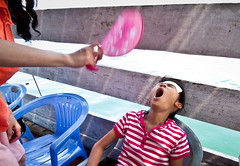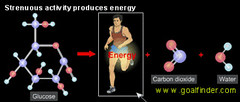By Dr. Dave Edenfield
Summer is in full swing. That means weekend barbecues, trips to the
amusement park with the kids and long walks on the beach. In Florida it also means heat stress, that
constant companion that dogs all of those
 |
| Sun Pillar (Photo credit: tomhe) |
brave enough to set foot outdoors in
July and August when the thermometer is on the far side of 90 degrees day in
and day out. For many people,
particularly displaced northerners, heat stress can quickly turn into heat exhaustion
or even heat stroke. So if you don’t
want to wind up being chauffeured to the local ER by a team of EMTs there are a
few things you need to understand in order to beat the heat this summer.
1.
Hydration
Trumps Prostration
Starting a three mile hike down a
nature trail clutching a can of Coke in the middle of July at high noon is one
sure way to wind up face down on the trail.
Experienced hikers know that you need to bring enough water to make a
long trek in the heat possible. Since
the body can lose up to a quart per hour on a hot day and the typical walking
pace is three miles per hour, you need to carry at least a half-gallon of water
if you are going to walk three miles and back.
2.
Made
in the Shade
If you do venture outdoors in the
summer, make sure you wear a hat or tote a beach or a golf umbrella to ward off
the Sun’s rays. Hats with wrap around
brims are preferred to ball caps, since they provide more shade and are not
worn tight against the scalp.
3.
Timing
is Everything
The best time to perform any kind
of strenuous activity in the summer is either early in the morning or after the
sun goes down. I have a neighbor who is
known to strap a bike headlight onto his mower in order to cut the grass at
8:30 pm.
4.
Dress
for Success
While that bathing suit shows off
your curves, it also allows the sun to dehydrate and overheat your body in the
shortest time possible. Particularly if
you plan on walking any distance in the hot sun, you need to sport the kind of
attire that retains moisture and keeps the body cool. At the very least a tee shirt is a must since
it helps to retain moisture which in turn helps to cool the body.
5.
Be
Aware If You Dare
If you insist on venturing outside
in the heat of the day, you need to be aware of the onset of heat-related
maladies since ignoring the early phases of heat stress can prove deadly.
Heat
Fatigue is typically caused by lack of hydration, as are
heat cramps. Both of these conditions
while not life threatening is your body’s way of telling you to slow down, seek
shelter from the sun and rehydrate. The
onset is usually a combination of fatigue and possibly muscle spasms. If you don’t heed these warning signs the
progression onto more serious conditions is imminent.
Heat
Exhaustion is the next rung up the ladder of heat stress. While this condition is common to athletes
who don’t know enough to get in out of the sun, it can also be experienced by
hikers and even the
occasional gardener who push their bodies too hard in the
summer heat. Think of the way your body deals
with heat as the radiator in your car.
As long as the radiator has sufficient fluid and the fan keeps turning,
your car has little trouble dealing with even the hottest of days. However, if the fan belt breaks or the
anti-freeze level drops, suddenly red lights start to light up on the dashboard
until the car sputters to a halt. The
human body works a lot like that. When it
is properly hydrated and attired it is possible to deal with the summer heat
without curtailing activities. However,
once the body’s core temperature exceeds 102 Fahrenheit, a cascade of events
begin to occur that lets you or those around you know that your internal
radiator is about to boil over. Symptoms
can include dizziness, stumbling, nausea or even chills. Internally the blood pressure will rapidly
drop and the pulse will race as the body tries desperately to shed excess
heat. If these symptoms manifest
themselves, the only solution is to seek shelter, rehydrate and cool the
victim. Failure to do so could lead to
heat stroke.
 |
| heat stroke (Photo credit: Shenghung Lin) |
Heat
Stroke occurs when the core temperature reaches or exceeds
105 degrees Fahrenheit. Signs of heat
stroke are slurred speech or disorientation. The next stage is unconsciousness and
possibly death unless rapid cooling and rehydration is performed immediately.
As a trained medical professional, I can’t stress
enough the nutritional factors that come into play in triggering heat-related
health issues. Recent studies have shown
that heat-related fatalities have risen more than three hundred percent in the
past two decades. Young people in
particular are far more prone to heat stroke due to the fact that teens and
young adults today consume far more caffeinated beverages than ever before. While that soda may feel refreshing as it
goes down it can actually dehydrate the body.
It isn’t unusual for teenage athletes to pass out or even die on the
ball field due to heat stroke. While
parents point the finger at coaches and trainers, in many cases it is the
athletes themselves who are also to blame since they push themselves beyond
their limits in order to keep from getting benched or cut from the team. In
order to prevent your child from succumbing to heat stroke you need to make
them aware of the warning signs of heat stress so that they will understand
when they or their friends need to head for the sidelines as opposed to being
carried off the field.
Certain drugs such as antihistamines and
antidepressants can also lower the tolerance for heat stress. In
 |
| Goalfinder exercise-produces-energy (Photo credit: gfinder) |
allergy season particularly this can be
problematic, since antihistamines not only dry the sinuses, they also dry the
mouth. They also reduce the body’s
ability to sweat freely. Particularly if
your child takes prescription allergy medication, or any medication that
impairs the body’s ability to sweat, you need to tell the coach.
By heeding the warning signs of heat stress and
using common sense to make certain that you and yours are properly attired, hydrated
and educated you don’t have to be afraid of venturing outdoors during the dog
days of summer. If your child is
involved in athletics also bear in mind that chiropractors can provide a world
of advice on sports training and nutrition that can help young athletes
maximize their performance while minimizing stress and injury.
Dr. Dave
Edenfield and Dr. Steven
Warfield are part of the team of doctors and
therapists at http://www.lakewoodchiropracticjax.com/ who
are dedicated to helping you and your family lead
healthier, happier and pain-free lives.


Its the 4th of July weekend. Drink plenty of water and and try avoiding falling victim to one of the illnesses listed in this article. Thanks Dr. Dave!
ReplyDeleteThe summer heat can be a real killer. I will definitely pass this information along to my family and friends.
ReplyDeleteHaving lived in such places as Tempe, Arizona and Las Vegas, Nevada, I can tell you with authority that vacationers don't appreciate the power of the Sun. While we Floridians don't experience triple digit temperatures very often, most of us know better then to plan excursions at midday in July and August. Unfortunately, that same logic fails most northerners who venture down here when the kids are out of school during the summer.
ReplyDelete